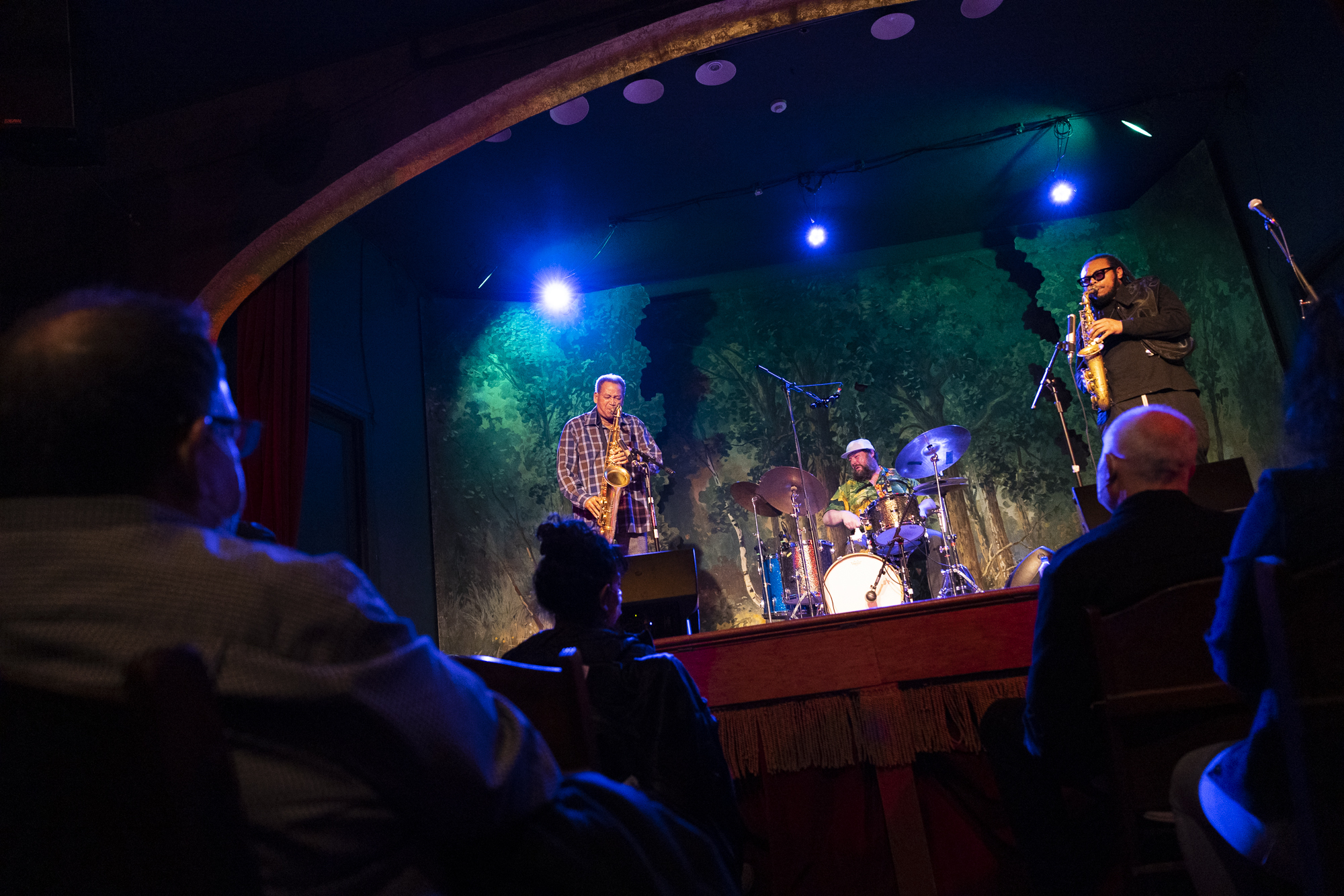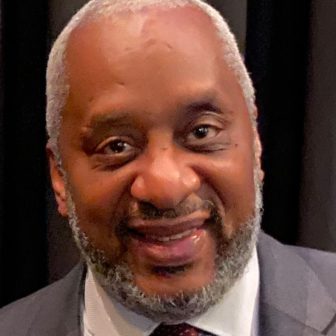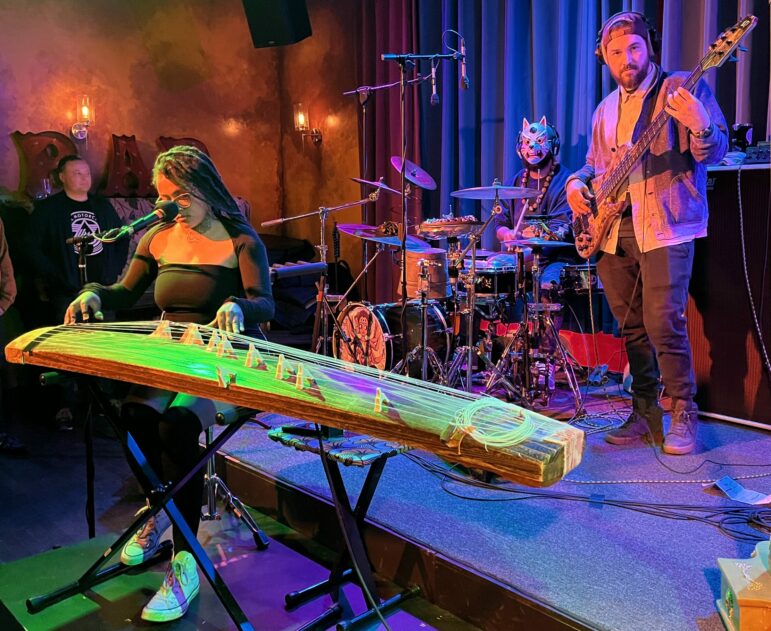Jazz Media Lab stations test strategies for cultivating younger audiences

WRTI
Odeon Pope, left, Kresten Osgood, and Immanual Wilkins perform at a March 31 event celebrating WRTI's “Dangerous Sounds” podcast.
Steve Williams was shocked when he saw the results of a market study of his station, WBGO in Newark, N.J.
“Our awareness level was below 50%,” said Williams, president since 2020. “When you consider that this station has been around for 43 years, it’s head-turning.”
At the same time, Williams saw that gap as a chance for WBGO to improve.
“Even though it was alarming, it was also super encouraging that there’s a lot of potential to grow the station’s audience,” he said. “So we had lots of opportunities to … develop the audience in ways that hadn’t been done previously.”
The market research was funded by the Jazz Media Lab, an initiative from 8 Bridges Workshop and the Doris Duke Charitable Foundation designed to improve audience development at five public radio jazz stations. The $1.3 million grant-funded project provides at least $225,000 to each station over three years. Participating with WBGO are WRTI in Philadelphia; KMHD in Portland, Ore.; KNKX in Tacoma, Wash.; and KUVO in Denver.
Unlike some grants that stipulate certain deliverables, the Jazz Media Lab grant terms were designed to be more flexible. The Doris Duke Charitable Foundation required that stations spend 2021, the first year of the grant program, discussing ideas. This spring they each received funding to actively pursue audience engagement events, said Maurine Knighton, the foundation’s program director for the arts.
A related innovation grant provides another $50,000 for addressing issues such as audience development and digital expansion. Some station leaders, like WRTI GM Bill Johnson, describe the innovation grants as “risk capital.”
“There are a lot of things that we don’t do because we really don’t have the financial resources to take a chance on them because they’re not the core operating expenses of running a radio station,” Johnson said. “Risk capital means: Do something that may or may not pay off. … By and large, a lot of music stations, jazz in particular, aren’t resourced to take those kinds of chances.”
Each station has its own interpretation of audience development. The Jazz Media Lab projects and innovation grants encompass live concerts, partnerships between jazz masters and young musicians, streaming apps and audits of the stations’ websites.
Williams used his initial funds from the Jazz Media Lab grant for a study of just over 700 listeners in the New York City Designated Market Area who were screened for their affinity for jazz and music.

“What we found was that we were not as balanced as we should be,” he said. “There was a desire to have the balance between the more contemporary sounds and jazz and the more traditional sound.”
Longtime members exhibited more conservative tastes and favored straight-ahead jazz, he said. Focusing solely on that loyal audience at the expense of more casual listeners, who are more open-minded about different genres and represent the most growth potential, was one reason why WBGO lost nearly half of its audience in the last year, he said.
In 2016, the station counted 400,000 listeners in its weekly cume, a high-water mark, Williams said. The most recent Nielsen ratings put the station’s weekly cume at 250,000, he added.
“It makes absolutely no sense that a station like WBGO, … in what many would consider to be the epicenter of jazz activity, both locally and globally, [would] have 250,000 listeners in a city with nearly 20 million listeners total,” Williams said. “That’s troublesome and that indicates a dysfunction somewhere in the programming.”
With the retirement of longtime host Michael Bourne and the death of producer Bob Porter, the market research guided WBGO in switching up its program schedule earlier this year. In February, the station expanded the broadcast footprint of the weekend show Rhythm Revue. Hosted by Felix Hernandez, the classic R&B and soul program draws WBGO’s biggest audiences and raises significantly more money than other shows, Williams said. The research also supported airing what some jazz aficionados might derisively call “smooth jazz,” he added.
“There are a lot of people out there who love that music, and it’s jazz, too — and we need to represent that,” he said. “That’s really in keeping not only with what the research tells us, but our mission statement proclaims this necessity for diversity, equity and inclusion.” The subgenre, also known as “contemporary jazz,” has been integrated into the music mix throughout the broadcast day.
Other stations within the Jazz Media Lab have struggled to expand their content to reflect the diversity of jazz subgenres. Although jazz is often known for a few specific eras, including be bop, big band and swing, it soaks up other types of music “like a sponge,” said Carol Handley, director of music programming at KNKX.
“That’s jazz’s dilemma at the moment, because we have been catering for many, many years to following the audience instead of, ‘Here’s what’s going on in jazz right now’ and letting the audience go through it,” she said. “So we find ourselves in a place where we need to pivot. The problem is, you cannot blow off where your money is. So you have to say, ‘How do we develop a younger audience without completely changing format?’”
KNKX is using its innovation grant to build an on-demand platform that will allow its audience to access an archive of tagged interviews and hear its original local programs through its website, phone app or their own smart speakers. The on-demand service will also function as a testing ground for on-air content. KNKX plans to use analytics of on-demand listening for decisions about its radio lineup and development of new shows, Handley said.

The process requires hours of coding, transcribing, search engine optimization and curation of thousands of digital files.
“There’s dollars involved here that we just didn’t really have to dedicate to this,” she said. “With the innovation grant, it gave us that opportunity to focus.”
KMHD is setting up a similar streaming service using its innovation grant. The service will organize shows so that users can navigate by mood. A listener who chooses a calming playlist, for example, will see recommendations for three or four KMHD shows that match that criteria, said Audience Engagement Director David Stuckey.
“Right now, you go to KMHD or you turn on the radio and you push the streaming service, you’re going to get what’s on the radio,” he said. “A lot of people don’t want to hear hip-hop in their jazz. … This is a way that you, the audience member, can be the program director.”
He expects that the troves of data gathered through the service will be key to building audiences across the board. If analytics show that listeners are using the digital platform for seven hours on a Saturday, that might be an opportunity to change the time when the newsletter is sent out, he said. Like KNKX’s on-demand platform, KMHD’s service could help the station experiment with on-air programming.
“If we keep seeing that people are requesting hip-hop or gospel, we don’t have a gospel show,” he said. “So if they want to hear more gospel jazz, if everybody is clicking on that, but it’s only one or two shows that comes up, we might think about, ‘Do we need to create a gospel show for broadcast?’”
‘New ideas that audiences will enjoy’
WGBO’s innovation grant supports a jazz media workshop for youth. The workshop selected four students from Jazz House Kids, a Montclair, N.J.–based nonprofit providing music mentorship to K-12 students, and will teach them how to produce radio programs and podcasts. The first four participants include a 17-year-old trumpet player, a 21-year-old singer, a 17-year-old drummer and a tenor saxophonist.
Each session of the 10-week training will dive into a different lesson, whether it’s a technical skill or tips on storytelling, said Doug Doyle, news director at WBGO. Billy Robinson, a veteran radio producer, teaches students digital editing and how to use Audacity, while Operations Assistant Corey Goldberg handles production techniques. Archivist and former producer Becca Pulliam will teach script-writing.The grant also funded the purchase of equipment for the program.
“What we hope is the end product that they have will be extremely interesting and provide new perspectives and new ideas that audiences will enjoy,” Doyle said. “I would think that with these four individuals, especially because they’re very interested in music, they’re going to come up with new and fresh angles on stories. That’s always the goal.”
The Jazz Media Lab grant has freed up resources for WRTI to pursue projects like the Dangerous Sounds podcast, an eight-part series exploring the history of jazz in Denmark. WRTI partnered with JazzDanmark and the Danish government to launch the series, and the partners hosted an intergenerational concert in March featuring Odean Pope, Kresten Osgood and Immanual Wilkins. The station will use video and audio footage from the event to create content for younger audiences, Johnson said.
WRTI invested some of its innovation grant into a residency program that pairs jazz masters and younger artists. The cross-generational partnership benefits its audience development initiatives in two ways, Johnson said. Collaborations between musicians who work in different genres, such as jazz and hip-hop, allow WRTI listeners to connect with a contemporary form of music. And the audiences that younger artists attract are exposed to jazz music, he added.
“That would give us an opportunity to not only record music, but … to have conversations with those artists and capture it not just for audio, but also visually, and produce a range of content for multiple platforms,” Johnson said. “Rather than just getting artists into the studio, recording and putting it on the air, our thought was we want to be able to create content that we think is going to work really well on social media platforms.”
One key to audience engagement is to avoid thinking of social media as a monolith, according to Johnson. To better serve audiences and leverage more financial support from their social media followers, stations should develop content that’s optimized for each specific platform, whether it’s Instagram, TikTok or Twitter, he said.
“We should be stepping into those spaces, even if they’re uncomfortable for us,” he said. “That’s where the opportunity is for growth.” Building WRTI’s social media presence will allow the station to interact more deeply and in new ways with its current audience, and help to extend its reach to nontraditional audiences who seek music on digital platforms.

In Denver, KUVO is leaning on advice from its younger staff as it produces concerts with funding from the innovation grant. Station managers are branching out of their comfort zone by hosting concerts at clubs and venues that don’t typically engage with KUVO, said Tina Cartagena, SVP of radio. KUVO produced a sold-out concert in March at Enigma Bazaar, a cocktail bar that showcases art and live performances, featuring the experimental electronic band Ramakhandra.
KUVO collected a healthy new tranche of email addresses from the concertgoers, according to Cartagena. Attracting those younger listeners is essential for a station with a listenership that’s predominantly over age 45, she said.
“They’re now in our database and we have created some cultivation paths,” Cartagena said, “to go from listener to being part of our core audience to becoming members or business leaders among us.”
Cartagena calls the Jazz Media Lab’s effect on her station “transformative.”
Like other stations in the cohort, KUVO has struggled with limited capacity, she said, but the influx of funds from the grant program has empowered staff members. It also helped focus the station’s long-term initiatives, a sentiment echoed by Williams of WBGO.
“I shudder to think where I would be in terms of the strategic goals that I set for this organization a year ago, without that assistance,” Williams said. “It’s truly a godsend for us.”






BGo should play more local artists and modern singers, balanced with the old ones. Michael Bourne got me out there; I’m an award-winning singer, pianist, composer, lyricist, arranger and producer of Brazilian jazz who grew up 10 minutes away from Newark. I’ve been told one of my early reels hangs on the wall in the station.
My current (third) CD ranked #6 last year on the Roots Music Report Latin jazz chart, but it’s only been aired three times that I know of on BGO! Many of my NY peers are in the same boat. At least KCR’s Som do Brasil show airs me in the NY area.
Personally I don’tcare for the doo wop Felix was playing today, other shows of his have been more bearable and even inspire dancing! All his extra hours are hours I won’t be listening, way too many. I don’t see the need for a Christian gospel show; a Jewish friend who has gotten play recently agrees it’s touchy terrain. The smooth jazz played excessively all day is so 90’s LA with the dated keyboards, drum machines of the day and simplistic melodies. Your young audience enjoys that?! It’s older than they are. I could understand if people are recording smooth jazz now, but who would bother? It’s been done to death. And it seems every other song is guitar, some of which is predictable acoustic melodies .
Many of us also don’t understand why Keana Faircloth and Greg Bryant were let go.
I am glad to hear more MPB (Brazilian pop music) in Portuguese.
Also you will do lay a 25 year old old cut by Steely Dan or Take 6, then repeat those very tracks soon after as if they are on a current chart. Why are these in rotation instead of the newest releases?
Lastly the barrage of the same constant station IDs is intolerable: What is jazz? Ladies and gentlemen, It’s my great pleasure to present Duke Ellington, Kamasi Washington, Joey Alexander. Mostly men and departed female singers. They cut in the middle of a song since the pandemic! At least change these IDs…entirely.
These comments are IMHO having listening since your inception,
Sue Maskaleris
http://www.suemask.com
I too would love to see new artists incorporated into playlists, those who can expand listenership, but are legit players and performers who challenge instead of pander, like James Francies, Kamasi Washington, Robert Glasper, Cecile McLorin Salvant, Esmeralda Spalding, Melanie De Biasio, Me’Shell N’degéocello. There’s a lot of mind-blowing stuff, and I feel that’s where the opportunity really is.